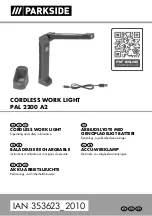
4
2. Introduction
The main feature of this LED PAR is, that it can be used as a 4-channel
DMX controller. In this mode 4 LED PARs have to be connected with XLR
cables on their DMX In-/Outputs.
The first LED PAR has to be set to DMX master mode. Now the LED
PAR in master mode sends control signals to the connected slaves.
There are different patterns available, e.g. all connected LED PARs do
the same, each shows different patterns, chaser programs, fade in – fade
out patterns and fade over patterns. The steps of the patterns can be
controlled by music beat or by a potentiometer. The music sensitivity is
controllable. The colour patterns offer a 100% colour mode, a 100% / 50%
colour mode, and a 100% / 75% / 50% /25% colour mode. The colours are
shown randomly.
A 3-channel DMX slave mode is supported, for easy connection in a DMX
system. All 512 channels are supported.
The unit also supports the stand alone modes colour change, fading
patterns, and fixed colour settings.
2.1 Supported function modes
2.1.1. Modes which support DMX input or DMX output
2.1.1.1 5-channel master mode
In this mode the LED PAR is used as a 4-channel DMX master.
The 5-channel master mode is offered to be compatible to the first version
of the LED PAR. The 5-channel master mode uses built-in functions of the
LED PARs, which will be controlled by the DMX signal.
There are different patterns available, e.g. all connected LED PARs do
the same, each shows different patterns, chaser programs, fade in – fade
out patterns and fade over patterns. The steps of the patterns can be
controlled by music beat or by a potentiometer. The music sensitivity is
controllable. The colour patterns offers a 100% colour mode, a 100%
/ 50% colour mode, and a 100% / 75% / 50% /25% colour mode. The
colours are shown randomly.
2.1.1.2 3-channel master mode
In this mode the LED PAR is used as a 4-channel DMX master.
The 3-channel master mode is offered for less consumption of DMX
channels, e.g. in case of connected DMX power packs or other DMX
receivers.





































